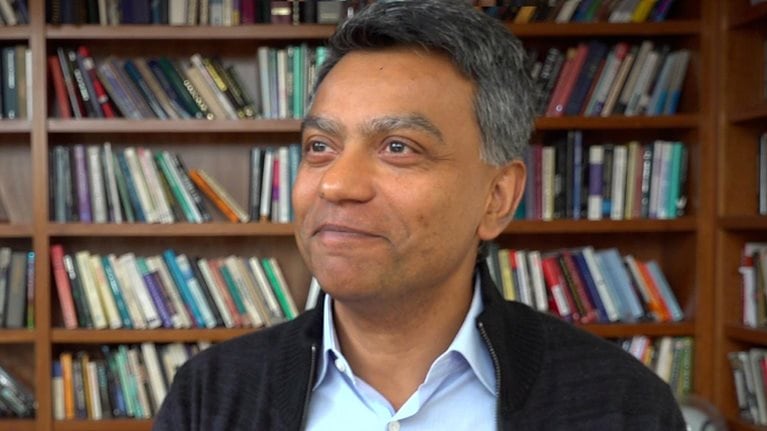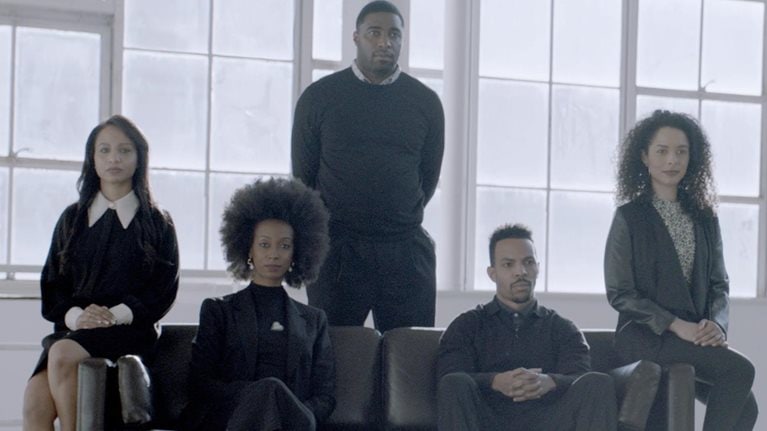Jeffrey Hirsch is the first to admit that he didn’t have much experience on the creative side of the entertainment business when he first joined Starz six years ago, having spent a decade and a half as a rising marketing executive at telecom giant Time Warner Cable. Even by the time he moved up from chief operating officer to president and CEO of Starz just six months before the pandemic began, Hirsch had never held sole responsibility for deciding which shows made the cut at a premium entertainment network.
But Hirsch has more than made up for lost time. Over the last couple of years, he has launched hit series that have raised Starz’ profile, including the 50 Cent-led Power franchise; built a thriving digital, direct-to-consumer business; and helped create a strong new brand identity focused on underrepresented audiences such as women of color. In the process, Hirsch has put Starz squarely at the forefront of a number of issues that are critical to the future of the film and TV industries: streaming and app development; global expansion; and diversity, inclusion, and equity on both sides of the camera. Hirsch recently spoke with Jonathan Dunn, a McKinsey senior partner and co-head of the firm’s Consumer Technology & Media practice. The edited conversation appears below.
The streaming experience in 2030
McKinsey: What do you think streaming looks like by the end of the decade? How different will the viewer’s experience be by then?
Jeffrey Hirsch: By 2030 I think it will be vastly different for the consumer. Today, technology is already shrinking the world, and it’s really becoming one kind of global marketplace for content. So I think by 2030 you will have content without borders, so to speak, where you’ll have content that will come from any part of the world that will be available to consumers all over the world. And with technology the consumer will be able to pick the language in which they want to hear the content. So the idea of a US- or UK-based story not traveling, I think that will all go away.
When a streaming service typically buys a show, the question is, “Where do you want to buy the rights?” But we are already trying to buy global rights so that we can put it on everywhere in the world. I mean, the shows that we’re developing in Spain, we see there’s a great role for them in the US and in Latin America, and in Europe, the Middle East, and North Africa. And it is the same with the shows we’re developing in India, where we’re using global casts because we feel those stories can play everywhere.
McKinsey: If streaming is going to globalize what have traditionally been local film and TV industries, what are the technologies, or ways consumers will use those technologies, that will be most disruptive?
Jeffrey Hirsch: I think there’s really two fundamental technologies that will advance or accelerate this kind of global footprint in streaming. One is compression technology, which is particularly important in less-developed parts of the world, like sub-Saharan Africa, where broadband as we traditionally know it here in the US is really kind of economically challenging to build. Where you can actually use compression technology to put HD movies, full features, and series onto mobile devices in a cost effective way, that really will accelerate the global footprint.
The second technology is voice recognition and the ability to quickly choose the language for the audio or subtitles. You should be able to quickly take a great story that was, say, created in Spain, and have it in the US or Saudi Arabia with the click of a button or just the sound of your own voice. So I think once those two technologies become fully deployed, you’ll see the global footprint really open up.
The streaming industry in 2030
McKinsey: As the industry continues its shift to streaming, what does competition look like for the streaming consumer of 2030, and where does Starz fit?
Jeffrey Hirsch: So to start with, you currently have these broad-based streamers that are really trying to compete to be that first subscription video on demand( SVOD) in the home, or the broad basic tier, as I like to call it. Here you’ve got everybody trying to take market share from Netflix, whether it’s HBO Max, Amazon, Hulu, or Disney+. That is where the competition is going to be the stiffest in the next 24 to 36 months.
Then there’s the premium tier, where we are. We’ve always played that very bespoke, focused, R-rated tier in the traditional ecosystem, which is a great complement to all of those broad-based services. We think that HBO to a certain extent is slotting out of that premium tier by going really broad with HBO Max. And Showtime is really becoming less of a focal point at Viacom because of Paramount+. That gives us a lot of white space in that adult premium tier.
You couple that with our unique focus on a diverse female audience, an underrepresented audience, and it makes us a great bundling partner with almost everybody in that first tier, not just in the US, but around the world. So whether it’s sitting on top of Netflix in the UK, or Amazon in Spain, or even back here at home in the US, sitting on top of Hulu or Amazon like we do today, I just think we’ll still be that great premium add-on to broad-based streaming services that are trying to be that first entry point into the home.
Research shows that consumers around the world will have between four and six SVOD services in their homes. We think Starz can be that number three or four SVOD in the home.
McKinsey: How much more consolidation do you foresee happening in the industry over the next decade?
Jeffrey Hirsch: As the world starts to become one global video marketplace, I think it is going to shrink and consolidate very quickly. For some of the largest entertainment companies with significant presences in sports and news, they have a very domestic business. But the future growth in streaming is going to be outside the US. So folks are going to look at what they have built and try to figure out who they can get to help make their footprint more global.
And so to me, mass consolidation is coming, whether it’s commercial consolidation on deals and bundles or full consolidation with M&A. It’s local over-the-air broadcasters in France consolidating with global players. As you get out in the next four to six years, people are really going to start to pull the best from each territory around the world and consolidate into these four to six global players that own the streaming businesses.

The future of video entertainment: Immersive, gamified, and diverse
Laying the foundation for Starz’s new identity
McKinsey: Starz, like many other streamers, has experienced a lot of growth during the pandemic. But you have been laying the foundation for that growth by expanding and fundamentally transforming your business over the last few years. Can you talk a little about that journey from when you joined the company?
Jeffrey Hirsch: Almost five years ago, we saw the consumer really shifting to SVOD. And I’ll be very honest about our position back then. We were a distant third, a premium movie service behind HBO and Showtime. My predecessor as CEO, Chris Albrecht, who was arguably the best creative executive in the history of the business from his time running HBO, had looked at the business and said, “it’s a very, very crowded field, with a lot of people doing similar stuff. We need to do something different.”
So we knew that we had to pivot faster than anybody else into where the consumer was going to give us the opportunity to grow the business and move Starz from an afterthought into kind of the center of the universe.
We felt if we bifurcated the business so that we had part of our organization focusing on our traditional wholesale cable business while we were using that kind of baseline to then pivot the business into this digital, retail side, we could be really successful.
Building a retail product at scale didn’t just give us a growing new business, it gave us a vehicle to obtain first-party data about our audience, and that was incredibly important. In the history of the traditional cable network business, generally speaking, the only data we got from our cable partners were, “Here’s what we’re paying you. And here’s how many subs you have.” But it didn’t tell us who our consumer was and what they were doing. And so it made it hard to continue to pick shows that would feed the business and grow because we didn’t understand our own consumer.
So we pivoted very quickly into launching an app at scale in April of 2015 to get that first-party data. And then we started to build the business.
McKinsey: What helped make that app become so critical to your new success?
Jeffrey Hirsch: We’ve always looked at designing technology from the standpoint of the consumer driving what we are building, rather than trying to build something to drive the consumer. And we did a lot of research around what was out there from competitors. I think in this case it was good to be second and third to the market, not first.
We saw a lot of customer confusion with many services’ having separate apps for existing cable customers and new streaming-only customers. And we wanted to make sure that we didn’t have that going forward. So we thought that one product with two front doors is a great way to remind the consumer the value they were already getting from our cable partners or to be able to buy the new direct-to-consumer service.
But I thought the ease and the simplicity of what we built was a great consumer experience. And that’s because the consumers were telling us that was the right thing to do.

Black representation in film and TV: The challenges and impact of increasing diversity
Building a brand around diverse, inclusive content
McKinsey: And what did you learn from that initial wealth of consumer data you finally had access to?
Jeffrey Hirsch: Well we saw five years ago what was actually driving our business, and that was underrepresented audiences and voices. As we got more and more of that data, we learned that it was women who were driving our business, in particular Latina and African-American women. And we turned that insight into a kind of programming mandate: we are going to put stories on the air that are by, for, and about women and underrepresented audiences.
Today, we have the largest composition of women ages 18-plus of any premium network. We have the largest composition of African Americans of every network. And we are the industry leader in putting underrepresented audiences on camera, behind the camera, in the director’s chair, in the writer’s room, and in the office. It’s who we are as a company. It’s our DNA. And it’s been super successful for our growth, both domestically and globally.
That early data gave us great confidence that we could actually expand rapidly around the world and continue to refine our programming strategy. We’ve reached an inflection point where we’re now more of a global streaming service based on data than we are a traditional linear premium cable network, with more global OTT subscribers than linear, cable subscribers.
McKinsey: How has that focus on diverse audiences impacted what Starz has to offer?
Jeffrey Hirsch: Well, initially, we saw great results from White Queen driving our subscription business. That led us to then say, “Okay, let’s find a show like Outlander,” which then led to continuing to fill that slate for that general female audience.
At the same time, we had started developing a show called Power, which has become our biggest hit and which is now, three spin-offs later, our biggest franchise.
I think the stories that we’re putting on the air reflect society today in a big way. We’ve got our show called Power Book III: Raising Kanan, which is part of the Power Universe franchise. It is the prequel story of Curtis “50 Cent” Jackson’s iconic character Kanan Stark, in which you follow him coming of age as his mother is teaching him the game in Jamaica, Queens, in 1990. I think it will be as good as anything that’s been on TV in the last ten years.
McKinsey: Have you been at all surprised by how successful this strategy has been at driving new growth for Starz?
Jeffrey Hirsch: I don’t think it was surprising to us, because the data confirmed for us that what we were doing was the right strategy. Just look at the global movement of people right now. Five years ago, the story on the street was that you couldn’t sell Power into France. Yet the Power Universe is our best performing show in France. If you look at France today, the makeup of the country has changed. Refugees have come in and out all over the world. So the makeup of what the world looked like five years ago is fundamentally different than it is today. And I think as the world continues to change and becomes more diverse, having representation on the screen and behind the screen and in the director’s chair that reflects the world that we live in today will become paramount to any company’s success.
McKinsey: How does this impact your approach to customer growth?
Jeffrey Hirsch: I think a lot of people are trying to grow their subscriber base, and it’s all through acquisition. Our goal is to continue to put content on to keep our core audiences. So we’re really playing more of a retention game right now than an acquisition game.
We don’t have to go find a show that can bring a new audience to us. We just have to find programming that will serve the audiences that we have. I think that’s been a real great differentiator. It’s been fun—we know the audience, so when we look at stories, we just have to ask, “Will it play for that audience?” And that’s a very different calculus from trying to do groundbreaking television to get vast amounts of new viewers to come to our service.
As the world continues to shrink and we continue to be two to three years ahead of everybody else with a global footprint, and we’re in these local markets looking for content that others aren’t, it again gives us a competitive advantage.
McKinsey: How has your embrace of diverse content and talent changed your relationship with the broader creative community in the business?
Jeffrey Hirsch: When we go out to talent, we’re finding that people want to be a part of what we are doing. I mean, we’ve got our Sharon Horgan half-hour with Courteney Cox and Greg Kinnear. We’ve got our Watergate anthology series from the perspective of Martha Mitchell with Julia Roberts and Sean Penn.
And I think those are not only stories that we never would have seen before, but they’re talent that we never would have had on the network before if it wasn’t for our commitment to this kind of storytelling.
Following Starz’s lead?
McKinsey: With your success, do you feel that your industry peers are starting to appreciate the importance, and potential payoff, of having diverse stories told by diverse creators and diverse decision makers?
Jeffrey Hirsch: I think it’s a mixed bag to be honest. On the creative side, I think there’s a ton more opportunity for diverse and fresh voices. Curtis “50 Cent” Jackson was an actor in Power and has become what I think is one of the best TV executives in the business right now. Kenya Barris is an example of another great creator who’s really developed.
And look at the dollars that Netflix has paid Shonda Rhimes. Look at folks in the executive suite over at Warner right now and at Universal Content Productions—diverse females who you haven’t seen before.
On the buying side, it’s still a little slower than I had hoped it to be. And that’s part of the reason we at Starz launched our #TakeTheLead initiative.
McKinsey: Tell us about #TakeTheLead. What do you hope it does for the industry and for society at large?
Jeffrey Hirsch: Well, first of all, #TakeTheLead is really the Starz story. It’s our commitment to putting diversity on the screen, behind the screen, and in the office to better reflect the world that we live in today. And it really comes out of our programming mandate: narratives for, by, and about women and underrepresented audiences.
We want to tell our story not only to the creative community, but to the country, in the hopes that we could impact and make other networks and other creators feel comfortable that our approach of putting diversity on the screen and behind the screen, and in the director’s or showrunner’s chair, is a great business strategy that can yield great success. We really want to hold up what we have done and continue to do as a kind of role model in the industry.
One of the core pillars of #TakeTheLead is a study that we did with the UCLA Center for Scholars & Storytellers that actually goes into our business and looks at all of our different key roles, whether it’s regulars on the screen, directors, showrunners, executives in the office, and compares our percentages of diversity in females in those roles to the industry as a way to hold ourselves accountable for what we believe.1
One of the statistics that I was really disappointed in is the number of females and underrepresented voices that we have in the director’s chair. Now, we’re somewhere north of 40 percent. The industry is 20 to 30 percent behind that number. So you could pat yourself on the back and say, “You know, 40 percent versus a much lower industry number, you’re doing great.” But based on our programming mandate, having somebody in the director’s chair that is authentic to the audience that we’re trying to attract and the story that we’re putting on the screen has to be consistent. I think that number should be higher, up in the 60s.
The second really big component of #TakeTheLead is our Transparency Talks. Every month we hold an event with a diverse set of NGOs to really address issues that are holding the industry back from actually building diversity on the screen, behind the screen, and in the office. I think it’s a great way to open up a conversation and keep it consistent month-to-month, so that this issue doesn’t become a burst where everybody talks about it, but then it goes away.
McKinsey: You mentioned the UCLA report that examined diversity in Starz’s own ranks, including the executive suite. How critical is it to have diversity in the office, not just on the studio lot?
Jeffrey Hirsch: You have to be authentic to the audience that you’re serving. And part of that is you need to have diversity of experience and talent in the building.
And so right now 75 percent of my direct reports are women. And half of those are women of color. If you go down into the creative shop, I would say over 80 percent of the entire original programming group are female. Over 46 percent of our senior vice presidents and higher in the building are women.
Leadership lessons from the pandemic
McKinsey: You took over as CEO about six months before the pandemic started. How challenging was that experience?
Jeffrey Hirsch: I didn’t take a class in business school about how to deal with a global pandemic; having 700 employees that are suddenly working from home, trying to keep everybody motivated and focused, and keeping the business simple in order to continue to grow and expand into 58 countries around the world.
Now, more than a year into the pandemic, we’re still challenged maintaining people’s mental health and keeping people focused on the business while they’re at home with families, in smaller apartments, in, say, New York City or in Denver. You have to be thinking about how to keep your employees not just focused, but healthy and excited. I just don’t think anybody is prepared for that, and I think we’ve struggled at times to keep people motivated.
I think we did a good job on the international expansion. Getting into 58 countries around the world while working from home and trying to negotiate distribution deals on Zooms and video cameras was like nothing we’ve ever experienced.
The other piece for me personally was that for the first time in my career I had full responsibility for a creative enterprise. Not only did I have the traditional cable business that I had grown up in, but now I had to deal with a whole different audience, which is creators. That meant looking at scripts, looking at content, trying to understand how to bring great pieces of content and stories onto the network to continue our growth, not only domestically, but also having to consider how they would play around the world.
I think what this experience has reaffirmed for me is that simplicity and focus on just two or three main things is really the only way you can be successful, whether it’s in a steady-state business or in a global pandemic. Anything after that, you really start to lose focus, and it becomes too complicated. At the end of the day, our business is pretty simple. We make a great show. We distribute it to our partners. And then we try to get people to watch it.
Comments and opinions expressed by interviewees are their own and do not represent or reflect the opinions, policies, or positions of McKinsey & Company or have its endorsement.


